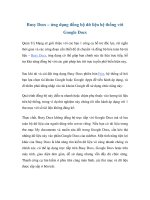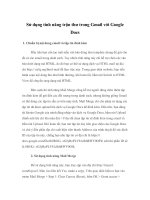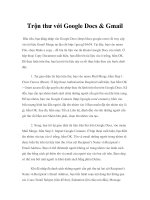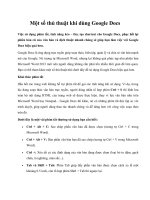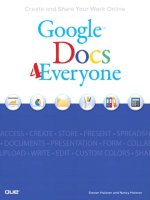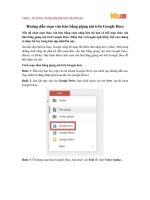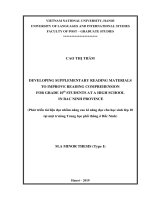Reading materials google docs (1)
Bạn đang xem bản rút gọn của tài liệu. Xem và tải ngay bản đầy đủ của tài liệu tại đây (107.42 KB, 6 trang )
1. Conservation Status of Wild Animals and Birds
heconservationstatusofwildanimalsandbirdsisacomplexandever-changingissue.Manyfactorscontributetothe
T
decline of wild populations, including habitat loss, poaching, and climate change.
abitat loss is one of the biggest threats to wild animals and birds. As humanpopulationsgrowandexpand,weare
H
encroaching on the natural habitats of many species. This can leadtofragmentationofhabitats,makingitdifficultfor
animals to find food and mates, and to move around freely.
oachingisanothermajorthreattowildanimalsandbirds.Poacherskillanimalsfortheirmeat,fur,andotherbodyparts,
P
whichareoftensoldontheblackmarket.Poachingcanhaveadevastatingimpactonwildpopulations,especiallythose
of endangered species.
limate change is also a serious threattowildanimalsandbirds.Climatechangeiscausingchangesintemperature,
C
precipitationpatterns,andsealevels.Thesechangescanhaveaprofoundimpactonthedistributionandabundanceof
wild species.
onservationeffortsareunderwaytoprotectwildanimalsandbirds.Theseeffortsincludeestablishingprotectedareas,
C
suchasnationalparksandwildliferefuges,crackingdownonpoaching,andeducatingthepublicabouttheimportance
of conservation.
Conservation status of wild animals
-
ccording to the IUCN Red List of Threatened Species, 27% of all mammal species are threatened with
A
extinction. This includes well-known species such as the African elephant, the black rhinoceros, and the
mountain gorilla.
Conservation status of wild birds
ccording to the IUCNRedListofThreatenedSpecies,13%ofallbirdspeciesarethreatenedwithextinction.
A
This includes well-known species such as the California condor, the Hawaiian crow, and the kakapo.
hat can be done to help?
W
-
There are many things that individuals can do to help conserve wild animals and birds. These include:
- Supporting conservation organizations. There are many organizations thatareworkingtoprotectwildanimals
and birds. You can support these organizations by donating money, volunteering your time, or spreading
awareness about their work.
- Reducing your impact on the environment.Wecanallreduceourimpactontheenvironmentbymakingsmall
changesinourdailylives,suchasrecycling,reducingourconsumptionofenergyandresources,andeatingless
meat.
- Educatingothersabouttheimportanceofconservation.Wecanallhelptoraiseawarenessabouttheimportance
of conservation by talking to our friends and family about the issue, and by sharing information on social media.
By taking these steps, we can all help to protect wild animals and birds for future generations.
Conservation Success Stories:
onservation efforts have yielded positive results for several species, demonstrating the crucial role of conservation
C
measures in safeguarding biodiversity.
-
iant Panda: Through habitat protection and captive breeding programs, the population of giant pandas has
G
increased, leading to the species being downgraded from endangered to vulnerable.
-
aldEagle:Stricterregulationsonpesticidesandhabitatprotectioncontributedtothesuccessfulrecoveryofthe
B
bald eagle population. This iconic bird is now considered a conservation success story.
Challenges and Future Directions:
- Despite progress, several challenges persist in wildlife conservation, warranting continued efforts.
- HabitatFragmentation:Habitatlossandfragmentationremainsignificantthreats.Conservationstrategiesshould
focus on restoring and creating corridors to connect fragmented habitats, ensuring the survival of diverse
species.
- ClimateChange:Risingtemperatures,alterationofrainfallpatterns,andsea-levelriseposeimmensechallenges
for wildlife. Conservation should include measures to mitigate and adapt to the impactsofclimatechangeon
vulnerable species.
- Illegal Wildlife Trade: The illegal trade ofwildlifecontinuestobeathrivingindustry,leadingtothedepletionof
numerous species. Enforcing stricter laws and international collaborations are necessarytocombatthisissue
effectively.
1. How are animals being protected?
2. What resources are in place to protect wildlife?
3. Why are many species of animals and birds endangered?
4. What are governments and individuals doing to protect wildlife?
5. Can animals and birds survive in the wild without humans’ protection?
6. Who should be in charge of wildlife protection, the government or individuals?
7.Despiteconservationefforts,thenumberofanimalsandplantsisdeclininginmanycountries.Whydoyouthinkitis
happening? How to solve this issue?
8. What are the three main threats to wild animals and birds?
9. What is habitat fragmentation and how does it affect wild animals and birds?
10. What is poaching and why is it a serious threat to wild animals and birds?
11. How is climate change impacting wild animals and birds?
12. What are some of the conservation efforts underway to protect wild animals and birds?
2. Animal Testing: Balancing Scientific Advancement and Ethical Considerations
ackground:
B
Animal testing, also known as animal experimentation or vivisection, involves using animals in scientificresearchto
gain knowledge that can benefit humans and other animals.
It has been an integral part of medical and scientific research for centuries, with notable achievements including the
development of vaccines, surgical techniques, and treatments for diseases.
Pros of Animal Testing: Scientific Advancement:
Animaltestinghasplayedaninstrumentalroleinadvancingmedicalknowledgeanddevelopinglife-savingtreatmentsfor
humans and animals alike. By testing new drugs, surgical techniques, and treatments on animals, researchers can
determinetheirefficacy,potentialsideeffects,andappropriatedosagesbeforemovingontohumantrials.Thisensures
the safety and effectiveness of medical interventions.
Disease Understanding and Treatment:
Animals serve asvaluablemodelsforstudyingthemechanismsofdiseasesanddevelopingeffectivetreatments.They
share physiological and genetic similarities with humans, making it possible tounderstandcomplexdiseasessuchas
cancer, heart disease, and neurological disorders through animal testing. This knowledge has paved the way for
improved diagnostic tools, preventive measures, and treatments for these conditions.
afety Assessment:
S
Animaltestingenablesresearcherstoevaluatethesafetyofpotentialdrugs,chemicals,andconsumerproductsbefore
humantrials.Bysubjectinganimalstocontrolledexperiments,scientistscanidentifyanypotentialharmfuleffects,such
sorgantoxicityorallergicreactions.Thisensuresthatonlysafeandreliableproductsreachthemarket,protectingthe
a
consumer and preventing harm.
thical Considerations: Animal Welfare:
E
There is a growing concern over the ethical implications of subjecting animals to experimentation. Critics argue that
animalshavetheirownrightsandshouldnotbeusedsolelyforhumanbenefit.Animaltestingcancauseunnecessary
suffering and harmtosentientbeings,andalternativesshouldbeexploredtominimizetheuseofanimalsinresearch.
Some people argue that animals have intrinsic value and deserve to be treated with respect and compassion. They
believethatusinganimalsfortestingpurposesisfundamentallyunethical,asitinvolvesthedeliberateinflictionofharm
onsentientbeingswithouttheirconsent.Meanwhile,regulationsandstandardsinplaceforanimaltestingareinsufficient
to ensure the welfare and ethical treatment of animals.
eliability and Translatability:
R
The results obtained from animal testing may not always accurately predict human responses due to differences in
biologicalsystemsandgeneticvariations.Humansandanimalsdifferintermsofmetabolism,anatomy,andsusceptibility
to certain diseases. Therefore, relying solely on animal models may not guarantee the effectiveness or safety of
interventions for humans.
echnological Advancements and Alternatives:
T
Advancementsintechnologyhaveledtothedevelopmentofalternativesthatcanreduceorreplacetheneedforanimal
testing. In vitro studies using human cells and tissues, computer modeling, and advanced imaging techniques offer
promisingalternativesthatprovidereliabledatawithoutinvolvinganimals.Thesemethodscanbridgethegapbetween
animal and human studies while minimizing ethical concerns.
nimals commonly used for testingpurposesvarydependingonthetypeofresearchandthespecificrequirementsof
A
the study. The choice of animals for testing is often based on factorssuchasgeneticsimilaritytohumans,biological
characteristics, and ethical considerations. Some of the most commonly used animals in scientific research include:
- Miceandrats:Thesesmallmammalsarewidelyusedduetotheirrelativelyshortlifespan,easeofhandling,and
geneticsimilaritytohumans.Theirreproductivecycleandphysiologyalsomakethemsuitableforawiderange
of tests.
- Guinea pigs: Guinea pigs have been used for decades in various research areas, including allergy and
respiratory studies. They have a similar physiological and immunological system to humans, making them
valuable for certain types of research.
- Rabbits: Rabbits are commonly used in testing for skin and eye irritation, as their skin is relatively similar to
human skin and their eyes are sensitive to certainsubstances.However,alternativemethodsareincreasingly
being developed to reduce the use of rabbits in such tests.
- Dogsandcats:Whiletheuseofdogsandcatsintestinghassignificantlydecreasedovertheyears,theyarestill
used in some specific research areas, such as toxicology and pharmacokinetics. However,theiruseishighly
controversial and heavily regulated due to the ethical concerns surrounding these companion animals.
.
1
2.
3.
4.
5.
6.
hat is another name for animal testing?
W
What animals are usually used for testing and why must it be these animals, not others?
What are the purposes of animal testing?
Is animal testing necessary?
Can animal testing be dispensed with?
Why do some people think that animal testing is cruel and unnecessary?
. Are Animals Necessary for Food, Medicines, and Clothing?
3
In recent years, there has been a burgeoning global debate surrounding the necessity of using animalsforfoodand
other essential products. With concerns about animal welfare, environmental impact, and advances in alternative
technologies,thequestionofwhetheranimalsarestillnecessaryfortheproductionoffood,medicines,andclothinghas
come to the forefront.
Food Production:
-
neoftheprimaryjustificationsforusinganimalsasafoodsourcehasbeentheneedtomeetthedemandfor
O
protein-rich diets. However, advances in plant-based alternatives and laboratory-cultured meat offer potential
solutionstoreducerelianceonanimalagriculture.Plant-basedmeatsubstituteshavegainedpopularityasthey
mimic the taste and texture of traditionalmeatwhilebeingmoreenvironmentallyfriendly.Moreover,lab-grown
meat,producedfromanimalcellswithoutharminganimals,couldrevolutionizethewayweproducemeat.These
alternatives pose a compelling argument that animals may no longer be a necessity for food production.
Medicines and Medical Research:
- Animaltestinghaslongbeenacontentiousissuewithinthescientificcommunity.Whileanimalshavehistorically
been utilized as models for understanding human health and testing potential treatments, advancements in
technology are challenging the necessity of such practices. Sophisticated in vitro models, organ-on-a-chip
systems, and computer simulations are being developed, offering more accurate representations of human
biology. While these alternatives may not entirely replace animal testing yet, they represent apromisingpath
forward and have the potential to render animal testing unnecessary.
Clothing and Fashion:
- Thefashionindustryhashistoricallyreliedonanimal-derivedmaterialssuchasfur,leather,andwool.However,
growing awareness of animal crueltyandenvironmentalconcernshasspurredthedevelopmentofcruelty-free
and sustainable alternatives. Faux fur, plant-based leathers, and innovative fabrics produced from recycled
materialsoragriculturalwastepresentviableoptionsthatbypassanimalexploitation.Withincreasingconsumer
demand for ethical fashion, the necessity of using animals for clothing production is being challenged.
Economic and Cultural Considerations:
- Oneoftheprimaryargumentsinfavorofcontinuingtouseanimalsforfoodandotherproductsrevolvesaround
economic viability and cultural traditions. Many industries and communities are economically dependent on
animalfarmingandharvesting.Transitioningawayfromanimal-basedpracticescouldhavewide-rangingimpacts
onthesesectors.Additionally,culturalandtraditionalpracticestiedtoanimaluseposechallengestocompletely
eliminating the necessity of animals.
hile there are emerging alternatives to using animals for food, medicines, and clothing,animalsarestillconsidered
W
necessary in certain contexts. Here are some reasons why animals are still utilized in these industries:
Food Production:
- Complete Nutritional Profile: Animal products, such as meat, dairy, and eggs, provide essential nutrients,
including complete proteins, vitamins, and minerals, that are vital for human health. While plant-based
alternatives are available, they may not always offer the same nutritional profile or availability of certain nutrients.
Cultural and Culinary Value:
- Animal products are deeply ingrained in the culinary traditions of variouscultures,playingasignificantrolein
their diets and cuisines. These cultural factors contribute to the ongoing demand for animal-based food products.
Medicines and Medical Research:
- ComplexBiologicalSystems:Animals,particularlymammals,possesscomplexbiologicalsystemsthatresemble
human physiology to varying degrees. This similarity makes them valuable for studying various diseases,
evaluating drug efficacy, and assessing potential adverse effects on living organisms.
Regulatory Requirements:
- Regulatory bodies, such astheFDA,oftenrequirepreclinicalanimaltestingtoassessthesafetyandpotential
toxicityofnewdrugsbeforehumanclinicaltrials.Thesetestshelpresearchersidentifypotentialrisksandrefine
drugformulations,ensuringhumansafety.Animalmodelsprovideawaytounderstandhowadrugortreatment
affects the whole organism, including interactions in the body and potential side effects that may not be
accurately replicated in vitro or computer models alone.
Clothing and Fashion:
- Unique Textile Properties:
Animal-derivedfibers,suchaswoolandsilk,possessuniquequalitiessuchaswarmth,insulation,durability,and
breathability that make them desirable for textile production.Despitealternativeslikefauxfurandplant-based
leathers, manufacturers still rely on animal fibers for specific applications.
- Cultural and Traditional Significance:
-
In certain cultures, animal-derived clothing holds cultural and traditional significance, representing heritage,
craftsmanship, and symbolism. Preserving these practices may require the continued use of animal-derived
materials.
Quality and Performance:
Animal-derivedmaterialsareoftenvaluedfortheirsuperiorqualityandperformanceinspecificapplications,such
as leather for durable footwear or down feathers for insulation in cold climates.
.
1
2.
3.
4.
hat are the main concerns surrounding the use of animals for food and other essential products?
W
What are some of the potential alternatives to animal-based food production?
How are advances in technology challenging the necessity of animal testing?
What are some of the ethical and environmental concerns associated with the fashion industry's use of
animal-derived materials?
5. What are some of the economic and cultural considerations that support the continued use of animals?
6. Why are animal products still considered necessary in certain contexts?
7. What are some of the challenges to completely eliminating the necessity of animals for food, medicines, and
clothing?
8. How can we balance the need for human well-being with the ethical concerns of using animals?
9. What are some of the most promising alternative technologies that could reduce our reliance on animals?
10. What role can individual consumers play in promoting the humane and sustainable use of animals?
NIMAL WELFARE + THE ENVIRONMENT
A
1.
Somepeoplethinkthattoomuchattentionandtoomanyresourcesaregiventotheprotectionofwildanimalsandbirds.
Do you agree or disagree?
2.
Some people say that it is necessary to use animals for testingmedicinesintendedforhumanuse.Others,however,
think it is cruel and unnecessary. Discuss both views and give your own opinion.
3.
Itisthenaturalprocessforanimalspeciestobecomeextinctandthere'snoreasonwhypeopleshouldtrytopreventthis
from happening. Do you agree or disagree?
4.
Somepeoplethinkthatzoosareallcruelandshouldbecloseddown.Othershoweverbelievethatzooscanbeusefulin
protecting wild animals. Discuss both opinions and give your own opinion.
5.
Inthemodernworld,itisnolongernecessarytouseanimalsasfoodorotherproducts,suchasmedicinesandclothing.
Do you agree or disagree?
TOPIC: THE ENVIRONMENT
. Nowadays, people have little awareness of the importance of the natural world / local history.
9
What are the reasons and how can people learn more about the natural world / local history?
10.
Many foods are shipped from far away. Some people think that eating local food is more environmentally and
economically beneficial. Do you think the advantages outweigh its disadvantages?
11.
Some people feel that manufacturers and supermarkets have the responsibilitytoreducetheamountofpackagingof
goods. Others argue that customers should avoid buying goods with a lotofpackaging.Discussbothviewsandgive
your opinion.
12.
Fossilfuels,suchascoal,oilandnaturalgas,arethemainsourceformanycountries.However,somenationsareusing
alternative energy such as solar power and wind power.Do you think this is a positive or negative development?
14.
lasticcontainershavebecomemoreprevalentthanever.Theyareusedinmanybusinessessuchasinthefoodand
P
beverage sector. Do you think the advantages outweigh disadvantages?
15.
Althoughitiswidelyrecognizedthatcarsdamagetheenvironment,theirmanufactureandusecontinuetoincrease.Why
is this the case? How could this increase be controlled?
16.
Thegovernmentshouldspendmoremoneyonmedicalresearchtoprotectcitizens’healthratherthanonprotectingthe
environment. Do you agree or disagree
17.
Majorcitiesintheworldaregrowingfast,aswellastheirproblems.Whataretheproblemsthatyoungpeoplelivingin
those cities are facing? Suggest some solutions.
18.
Somehumanactivitieshavenegativeeffectsonplantandanimalspecies.Somepeoplethinkitistoolatetodoanything
aboutthisproblemwhileothersthinkeffectivemeasurescanbetakentoimprovethissituation.Discussbothviewsand
give your opinion.
19.
Research has shown that the transportation of products and people are the main source of pollution. Some people
believethegovernmentisresponsible,whileothersbelieveitisthefaultofindividuals.Discussbothviewsandgiveyour
opinion.
20.
Somepeoplethinkthatthegovernmentshouldstrictlycontrolthesupplyoffreshwater,whileothersthinkwecanuseas
much water as we want. Discuss both views and give your opinion.
21.
Environmental damage is the problem of most countries. Whatfactorsdamagetheenvironmentandwhoshouldtake
responsibility?
22.
The best way tosolvetheworld'senvironmentalproblemistoincreasethecostoffuelforcarsandothervehicles.To
what extent do you agree or disagree?
23.
Theincreaseintheproductionofconsumergoodsresultsindamagetothenaturalenvironment.Whatarethecausesof
this? What can be done to solve this problem? (Causes - Problems - Solutions)
24.
Nowadays people waste a lot of food that was bought from shops and restaurants.
Why do you think people waste food?
What can be done to reduce the amount of food they throw away?
25.
Environmental damage is the problem of most countries.
What factors damage the environment and who should take responsibility?
26.
Somehumanactivitieshavenegativeeffectsonplantandanimalspecies.Somepeoplethinkitistoolatetodoanything
aboutthisproblemwhileothersthinkeffectivemeasurescanbetakentoimprovethissituation.Discussbothviewsand
give your opinion.
27.
Research has shown that the transportation of products and people are the main source of pollution. Some people
believethegovernmentisresponsible,whileothersbelieveitisthefaultofindividuals.Discussbothviewsandgiveyour
opinion.
28.
It is now possible for scientists and tourists to travel to remote natural environments,suchastheSouthpole.Dothe
advantages of this development outweigh the disadvantages?


